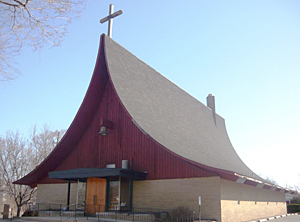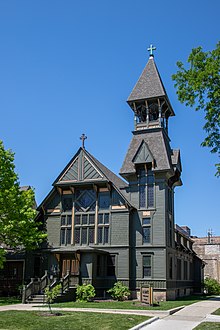
Lakeview, also spelled Lake View, is one of the 77 community areas of Chicago, Illinois. Lakeview is located in the city's North Side. It is bordered by West Diversey Parkway on the south, West Irving Park Road on the north, North Ravenswood Avenue on the west, and the shore of Lake Michigan on the east. The Uptown community area is to Lakeview's north, Lincoln Square to its northwest, North Center to its west, and Lincoln Park to its south. The 2020 population of Lakeview was 103,050 residents, making it the second-largest Chicago community area by population.

Francis Eugene George was an American prelate of the Catholic Church. He was the eighth Archbishop of Chicago in Illinois (1997–2014) and previously served as bishop of the Diocese of Yakima and Archbishop of Portland.

The Church of the Intercession is an Episcopal congregation located at 550 West 155th Street, at Broadway, on the border of the Harlem and Washington Heights neighborhoods of Manhattan, New York City, on the grounds of Trinity Church Cemetery. The congregation was founded in 1846, and the current sanctuary, built in 1912–1915, was designed by Bertram Grosvenor Goodhue in the Gothic Revival style. From 1906–1976, it was a chapel of Trinity Church.

Willow Creek Community Church is an Evangelical non-denominational multi-site megachurch based in the northwestern Chicago suburb of South Barrington, Illinois. It was founded on October 12, 1975 by Dave Holmbo and Bill Hybels, who was its longtime senior pastor. Willow Creek has seven locations in the Chicago area, and their Spanish-speaking congregations, Willow Español, at the South Barrington and South Lake in Lincolnshire, campus.

Portage Park is located on the northwest side of the City of Chicago, Illinois and is one of 77 officially designated Chicago community areas. Portage Park is bordered by the community areas of Jefferson Park and Forest Glen to the north, Dunning and the suburb of Harwood Heights to the west, Irving Park to the east and Belmont-Cragin to the south.

Carlton D'Metrius Pearson was an American Christian minister and gospel music artist. At one time, he was the pastor of the Higher Dimensions Evangelistic Center Incorporated, later named the Higher Dimensions Family Church, which was one of the largest churches in Tulsa, Oklahoma. During the 1990s, it grew to an average attendance of over 6,000.

The Cathedral Church of Saint Matthew, known simply as St. Matthew's Cathedral, is an Episcopal cathedral church located at 5100 Ross Avenue in Dallas, Texas, in the United States.

Saint John Cantius Church is a historic Catholic church of the Archdiocese of Chicago known for its architecture, liturgical practices, and affiliation with the Canons Regular of St. John Cantius.
Faith in Place is an American organization based in Chicago, Illinois that coordinates religious leaders to address environmental sustainability issues. Partnering with religious congregations, Faith in Place promotes clean energy and sustainable farming. Since 1999, Faith in Place has partnered with over 700 congregations in Illinois.

Blase Joseph Cupich is an American prelate of the Roman Catholic Church, a cardinal who serves as archbishop of the Archdiocese of Chicago.

St. John's Cathedral is an Episcopal church near downtown Los Angeles that serves as both a parish church and the cathedral church of the Episcopal Diocese of Los Angeles, an area covering five and a half counties. Though St. John's was formed in 1890, the current Romanesque Revival architectural style church was built in 1925. It was listed in the National Register of Historic Places in 2000.

The Third Unitarian Church (TUC) is a Unitarian Universalist church in the West Side of Chicago, Illinois, United States. It was founded in November 1868. Because of its pioneering architecture for its day, it has become much of a landmark in Chicago, and is now an official landmark. The church is liberal and describes itself as "a progressive, welcoming, and diverse congregation".

William Dailey Persell is an American bishop, formerly the bishop of the Episcopal Diocese of Chicago (1999–2008).

The Fourth Presbyterian Church of Chicago is one of the largest congregations of the Presbyterian Church (U.S.A.), located in the Magnificent Mile neighborhood of Chicago, directly across Michigan Avenue from the John Hancock Center.
The Salem Baptist Church is a Baptist megachurch located at 752 E 114th Street in the Pullman neighborhood of Chicago, Illinois, United States. The senior pastor is Charlie Dates.

The Ravenswood branch is a 4.7 mi (7.6 km) long branch of the Chicago "L" in Chicago, Illinois. Operated by the Chicago Transit Authority, it carries the Brown Line. As of February 2013, an average of 30,949 passengers are served each weekday on this branch.

St. Augustine's Episcopal Church in Gary, Indiana, is a historically black congregation and building in the Episcopal Diocese of Northern Indiana. The congregation was chartered in 1927, and the building, constructed in 1958, was listed on the National Register of Historic Places in 2013 after being nominated for listing by parishioner Paula M. DeBois.

Jeffrey Dean Lee is a bishop of the Episcopal Church who served as the Twelfth Bishop of Chicago from 2008 to 2020.

Daprato Rigali Studios is a nationally-recognized interior restoration and renovation company in Chicago. It was founded in 1860 by the Daprato brothers, Italian immigrants from the town of Barga. The company specializes in interior renovations and restorations of historic and iconic buildings such as churches, theaters, hotels, banks, courthouses and commercial building lobbies. They specialize in project management and include decorative painting, stained glass and marble fabrication departments.

Blessing of animals can be either of the animal or of the human-animal relationship, and can apply to pets and other companion animals, or to agricultural animals and working and other animals which humans depend on or interact with.






















